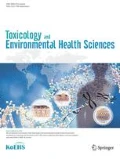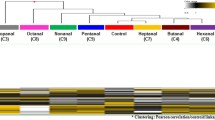Abstract
Low-molecular weight saturated aliphatic aldehydes (LSAAs), which include propanal, butanal, pentanal, hexanal, octanal, nonanal and heptanal, are volatile organic compounds (VOCs). They are ubiquitous in the environment of our daily life. Although LSAAs are harmful, with mutagenic and carcinogenic effects, the mechanisms underlying the toxicity of volatile aldehydes are still unclear. Therefore, in this study, we performed genome-wide expression profile analysis of A549 human alveolar epithelial cells exposed to seven LSSAs. We selected genes whose expression was changed more than 1.5-fold in A549 cells exposed to LSAAs by analysis of gene expression profiles using human oligonucleotide chips. Through gene expression profiling, we showed that LSSAs are related to the key biological processes “defense response”, “inflammatory response” and “immune response” in gene ontology (GO) analysis. In addition, we identified two genes that were up-regulated (GREB1, BC009808) and four that were down-regulated (UCP1, TCP11, FNDC3A, LOC645206) by all the tested LSAAs. Our data suggest that LSAAs exert toxic effects on A549 cells by modulating mRNA expression. Moreover, we suggest that genes expressed in response to LSAAs represent a molecular signature that can be widely used, in combination with more traditional techniques, to assess and predict the toxicity caused by exposure to LSAAs.
Similar content being viewed by others
References
Dassonville, C., Demattei, C. & Laurent, A. M. Assessment and predictor determination of indoor aldehyde levels in Paris newborn babies homes. Indoor Air 19, 314–323 (2009).
Baumann, M. G. D. et al. Aldehyde emissions from particleboard and medium density fiberboard products. Forest Products Journal 50, 75–81 (2000).
Nazaroff, W. W. & Weschler, C. J. Cleaning products and air fresheners: exposure to primary and secondary air pollutants. Atmos. Environ. 38, 2841–2865 (2004).
Wolkoffa, P. et al. Risk in cleaning: chemical and physical exposure. Sci. Total Environ. 215, 135–156 (1998).
Sarigiannis, D. A. et al. Exposure to major volatile organic compounds and carbonyls in European indoor environments and associated health risk. Environ. Int. 37, 743–765 (2011).
Fullana, A., Carbonell-Barrachina, A. A. & Sidhu, S. Volatile aldehyde emissions from heated cooking oils. J. Sci. Food Agric. 84, 2015–2021 (2004).
Kays, S. J., Hatch, J. & Yang, D. S. Volatile Floral Chemistry of Heliotropium arborescenes L. ‘Marin’. HortScience 40, 1237–1238 (2005).
Phillips, M. et al. Volatile organic compounds in breath as markers of lung cancer: a cross-sectional study. Lancet 353, 1930–1933 (1999).
Corradi, M. et al. Aldehydes in exhaled breath condensate of patients with chronic obstructive pulmonary disease. Am. J. Respir. Crit. Care Med. 167, 1380–1386 (2003).
Fuchs, P. et al. Breath gas aldehydes as biomarkers of lung cancer. Int. J. Cancer 126, 2663–2670 (2010).
Mazzone, P. J. Exhaled breath volatile organic compound biomarkers in lung cancer. J. Breath Res. 6, 027106 (2012).
Kato, S. et al. Formaldehyde in human cancer cells: detection by preconcentration-chemical ionization mass spectrometry. Anal. Chem. 73, 2992–2997 (2001).
Guadagni, R. et al. Solid-phase microextraction-gas chromatography-mass spectrometry method validation for the determination of endogenous substances: urinary hexanal and heptanal as lung tumor biomarkers. Anal. Chim. Acta 701, 29–36 (2011).
Yazdanpanah, M. et al. Cytotoxic aldehydes as possible markers for childhood cancer. Free Radic. Biol. Med. 23, 870–878 (1997).
Park, S. J. State of the Art of the Deodorizing Technology in Korea. Available from: http://www.orea.or.jp/en/PDF/2004-06.pdf.
Kohlpaintner, C., Schulte, M., Falbe, J., Lappe, P. & Weber, J. Aldehydes, Aliphatic and Araliphatic. Ullmann’s Encyclopedia of Industrial Chemistry Wiley-VCH, Weinheim, Germany (1999).
Sanchez, B. C., Carter, B., Hammers, H. R. & Sepúlveda, M. S. Transcriptional response of hepatic largemouth bass (Micropterus salmoides) mRNA upon exposure to environmental contaminants. J. Appl. Toxicol. 31, 108–116 (2011).
Kwon, J. Y., Kim, J. M., Ji, Y. H. & Seo, Y. R. Genome-wide microarray investigation of molecular targets and signaling networks in response to high-LET neutron in in vivo-mimic spheroid of human carcinoma. Mol. Cell. Toxicol. 8, 9–18 (2012).
Song, M. K. et al. Gene Expression Analysis Identifies DNA Damage-related Markers of Benzo[a]pyrene Exposure in HepG2 Human Hepatocytes. Toxcol. Environ. Health. Sci. 4, 19–29 (2012).
Song, J. W. et al. Environmental lung diseases: Clinical and imaging findings. Clin. Radiol. doi:pii: S0009-9260(12)00415-1. 10.1016/j.crad.2012.07.012 (2012).
Berthier, A. et al. The novel antibacterial compound walrycin A induces human PXR transcriptional activity. Toxicol. Sci. 127, 225–235 (2012).
Fan, Y. et al. Long-term exposure to hexavalent chromium inhibits expression of tumor suppressor genes in cultured cells and in mice. J. Trace Elem. Med. Biol. 26, 188–191 (2012).
Fabbri, M. et al. Whole genome analysis and micro-RNAs regulation in HepG2 cells exposed to cadmium. ALTEX 29, 173–182 (2012).
Cho, Y. E. et al. In-depth identification of pathways related to cisplatin-induced hepatotoxicity through an integrative method based on an informatics-assisted label-free protein quantitation and microarray gene expression approach. Mol. Cell Proteomics 11, M111. 010884 (2012).
Huang, S. X. et al. Mitochondria-derived reactive intermediate species mediate asbestos-induced genotoxicity and oxidative stress-responsive signaling pathways. Environ. Health Perspect. 120, 840–847 (2012).
Black, M. B. et al. Cross-species comparisons of transcriptomic alterations in human and rat primary hepatocytes exposed to 2,3,7,8-tetrachlorodibenzo-pdioxin. Toxicol. Sci. 127, 199–215 (2012).
Bourdon, J. A. et al. Hepatic and pulmonary toxicogenomic profiles in mice intratracheally instilled with carbon black nanoparticles reveal pulmonary inflammation, acute phase response, and alterations in lipid homeostasis. Toxicol. Sci. 127, 474–484 (2012).
Blanc, P. D. Emerging Occupational and Environmental Respiratory Diseases. Available from: http://www.chestnet.org/accp/pccsu/emerging-occupationaland-environmental-respiratory-diseases?page=0,3.
Yao, H. et al. Protein kinase C zeta mediates cigarette smoke/aldehyde- and lipopolysaccharide-induced lung inflammation and histone modifications. J. Biol. Chem. 285, 5405–5416 (2010).
Fink, B. D. & Reszka, K. J. Respiratory uncoupling by UCP1 and UCP2 and superoxide generation in endothelial cell mitochondria. Am. J. Physiol. Endocrinol. Metab. 288, E71–E79 (2005).
He, Z. Y., Wen, H. & Shi, C. B. Up-regulation of hnRNP A1, Ezrin, tubulin β-2C and Annexin A1 in sentinel lymph nodes of colorectal cancer. World J. Gastroenterol. 16, 4670–4676 (2010).
Heo, J. D., Oh, J. H. & Lee, K. Gene expression profiling in the lung tissue of cynomolgus monkeys in response to repeated exposure to welding fumes. Arch. Toxicol. 84, 191–203 (2009).
Zhang, L., Xiao, H. & Zhou, H. Development of transcriptomic biomarker signature in human saliva to detect lung cancer. Cell. Mol. Life Sci. 69, 3341–3350 (2012).
Xu, X. et al. Long-term exposure to ambient fine particulate pollution induces insulin resistance and mitochondrial alteration in adipose tissue. Toxicol. Sci. 124, 88–98 (2011).
Nam, Y. H., Lee, S. K., Sammut, D., Davies, D. E. & Howarth, P. H. Preliminary study of the cellular characteristics of primary bronchial fibroblasts in patients with asthma: expression of alpha-smooth muscle actin, fibronectin containing extra type III domain A, and smoothelin. J. Investig. Allergol. Clin. Immunol. 22, 20–27 (2012).
Zhang, L. et al. Development of transcriptomic biomarker signature in human saliva to detect lung cancer. Cell Mol. Life Sci. 69, 3341–3350 (2012).
Parsanejad, R., Fields, W. R., Morgan, W. T., Bombick, B. R. & Doolittle, D. J. The time course of expression of genes involved in specific pathways in normal human bronchial epithelial cells following exposure to cigarette smoke. Exp. Lung Res. 34, 513–530 (2008).
Author information
Authors and Affiliations
Corresponding author
Rights and permissions
About this article
Cite this article
Lee, H.S., Yoon, JS., Song, M. et al. Gene expression profiling of low dose exposure of saturated aliphatic aldehydes in A549 human alveolar epithelial cells. Toxicol. Environ. Health Sci. 4, 211–217 (2012). https://doi.org/10.1007/s13530-012-0140-7
Received:
Revised:
Accepted:
Published:
Issue Date:
DOI: https://doi.org/10.1007/s13530-012-0140-7



